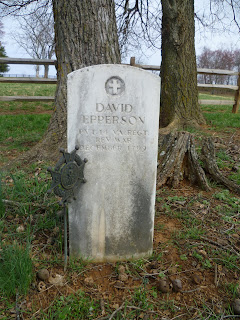It has been a while since we've posted here. The flow of new information slowed down, we got busy and we unfortunately didn't keep up with the blog. Well, I'm going to try to do a better job of posting things from time to time.
I'm going to start with a new find related to John William Allen.
Today, I was searching the Library of Virginia site and came across a record for the Lawson House in the Virginia Historical Inventory. This collection was originally assembled by the Virginia Writer's Project, a part of the depression-era Works Progress Administration. It documented thousands of historic homes and sites across Virginia. You can search the collection
here.
One of the entries in this collectino describes the Nick Lawson house. The location described in the pages below, matches that of John William Allen's homeplace. We also see that the owner and occupier of the house, as well as this report's informant, is listed as J. A. Allen. This would appear to be John Arthur, John William's son. The description of the house on page three also matches that of photos we have (see below). There is no doubt that we've found a record on the old Allen home.


So, we know this is the Allen home, so who was Nick Lawson?? As we've
posted before, John William Allen purchased, in 1900, 166 acres of land in Greene County. A portion of that deed is listed here:
This Deed made this Oct 15, 1900 between F.M. McMullan [?] hereinafter
described of one part and John W. Allen of the other part. Whereas
said F.M. McMullan & R.S. Thomas [?] in the suit of H.S. Collier vs
Lawson in Greene Circuit Court in pursuant of the decree entered in
the said cause at Nov term 1894 of said court made public sale on
March 13, 1895 of the Martin Collier Home Place of 166 acres 2 roods
13 poles of land.
As you can see, the land that was purchased was called the Martin Collier homeplace. As it turns out, a Nicholas Lawson married a daughter, Texanna, of Martin Collier. The H. S. Collier mentioned in the deed is most likely Hudson S. Collier, a son of Martin Collier. Apparently there was an issue with the purchase or transfer of the land between Nicholas Lawson and Hudson Collier that allowed John Allen to purchase it.
Some more digging into Nicholas Collier reveals that is his full name was John Nicholas Lawson. He was born in 1841 in Rockingham County. As it turns out, the Lawsons were neighbors with the Maidens. Nicholas Lawson's family is listed immediately above William and Sarah Maiden (parents of John T. Maiden and grandparents of Mary Clementine Maiden Allen) in the 1860 census. Nicholas then married Texanna Collier and moved to Greene County.
It seems obvious now that there the Lawsons, Colliers, Maidens and later Allens all were closely associated with and knew each other well. More research is needed to find out the reasons behind the court case that led to John Allen's purchase of the land in Greene County.


























